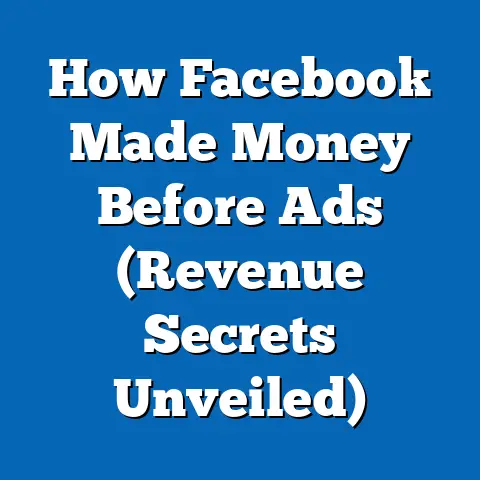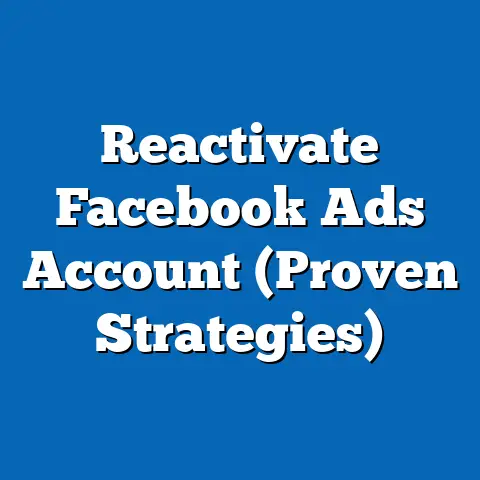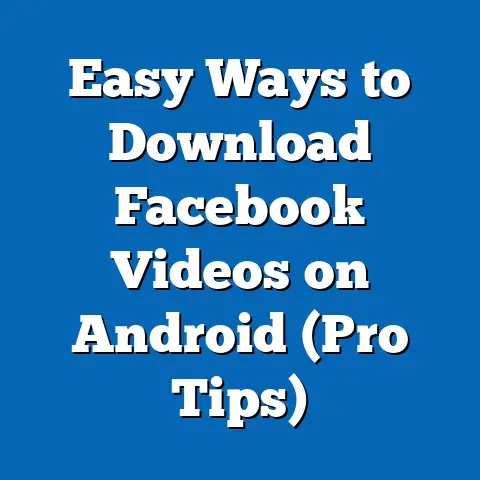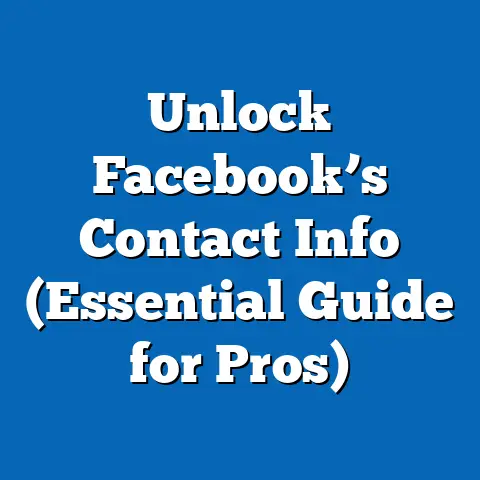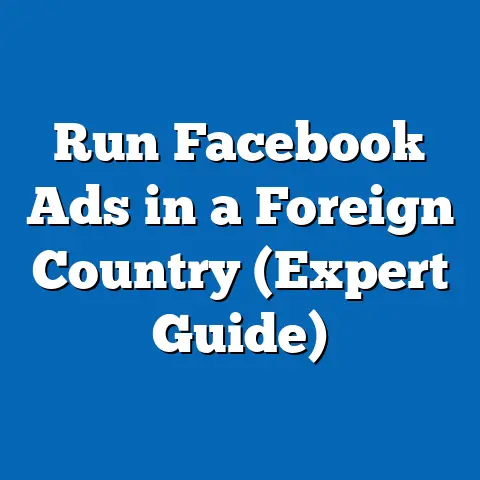Revamp fb ad Schedule for Maximum Impact (Proven Strategies)
Facebook advertising is a powerful tool, but it’s not a “set it and forget it” kind of thing. I’ve seen countless campaigns underperform, not because the creative was bad or the targeting was off, but simply because the ads were running at the wrong times. Think of it like this: you wouldn’t serve breakfast at dinner, right? The same logic applies to your Facebook ads. An effective ad schedule can significantly enhance your campaign performance, boost engagement rates, and ultimately drive those crucial conversions.
I remember once working with a local coffee shop. Their ads were running 24/7, and they were scratching their heads why they weren’t seeing more foot traffic. After diving into their data, we discovered that their peak hours for in-store visits were between 7 AM and 10 AM. By focusing their ad spend during those hours, and specifically targeting people within a 1-mile radius, we saw a 30% increase in morning customers within the first two weeks. That’s the power of a well-optimized ad schedule!
The truth is, consumer behavior is dynamic. Your audience might be more receptive to your message at certain times of the day, week, or even year. Different demographics have different online habits, and ignoring this can be a costly mistake. So, let’s dive into how you can revamp your Facebook ad schedule and unlock its full potential.
Understanding Room-Specific Needs
The concept of “room-specific needs” is something I’ve developed over years of managing Facebook ad campaigns. What I mean by this is that you need to tailor your ad schedules based on the unique characteristics and behaviors of your target audiences. It’s like decorating different rooms in a house – the living room needs different furniture and lighting than the bedroom.
Consider these factors:
-
Age Groups: Younger audiences are often glued to their phones in the evenings and late at night, scrolling through Instagram and catching up on the latest trends. Older demographics, on the other hand, might be more active during the day, checking Facebook for news updates or connecting with family. Think about the “when” as much as you think about the “who.”
-
Geographic Locations: Time zones are the obvious factor here, but cultural habits also play a big role. A business targeting a global audience needs to consider peak engagement times in different regions. For instance, an ad promoting a late-night snack might perform well in a city with a vibrant nightlife, but fall flat in a more conservative area where people tend to go to bed early. I once ran a campaign for a language learning app that targeted both the US and Japan. By scheduling ads to align with after-work hours in each country, we saw a significant increase in app downloads.
-
Industry-Specific Trends: Certain industries have specific peak times for engagement. Retail businesses often see a surge in online activity during holidays and weekends. Fitness businesses typically experience a spike in interest at the start of the year as people set New Year’s resolutions. Understanding these trends can help you time your ads for maximum impact. For example, if you’re promoting a tax preparation service, you might want to ramp up your ad spend in the weeks leading up to tax deadlines.
Age Groups: Younger audiences are often glued to their phones in the evenings and late at night, scrolling through Instagram and catching up on the latest trends. Older demographics, on the other hand, might be more active during the day, checking Facebook for news updates or connecting with family. Think about the “when” as much as you think about the “who.”
Geographic Locations: Time zones are the obvious factor here, but cultural habits also play a big role. A business targeting a global audience needs to consider peak engagement times in different regions. For instance, an ad promoting a late-night snack might perform well in a city with a vibrant nightlife, but fall flat in a more conservative area where people tend to go to bed early. I once ran a campaign for a language learning app that targeted both the US and Japan. By scheduling ads to align with after-work hours in each country, we saw a significant increase in app downloads.
Industry-Specific Trends: Certain industries have specific peak times for engagement. Retail businesses often see a surge in online activity during holidays and weekends. Fitness businesses typically experience a spike in interest at the start of the year as people set New Year’s resolutions. Understanding these trends can help you time your ads for maximum impact. For example, if you’re promoting a tax preparation service, you might want to ramp up your ad spend in the weeks leading up to tax deadlines.
Example:
Let’s say you’re selling organic baby food. Your target audience is likely parents with young children. These parents might be most active on Facebook during naptime or after the kids are in bed. Running your ads during these times could lead to higher engagement and more sales. Consider A/B testing different time slots to pinpoint the most effective schedule.
Key Takeaway: Before you even think about setting up your ad schedule, take the time to truly understand your target audience. What are their online habits? When are they most likely to be on Facebook? Answering these questions will lay the foundation for a successful ad campaign.
Proven Strategies for Optimal Ad Scheduling
Okay, so you’ve got a solid understanding of your audience. Now, let’s dive into some proven strategies for revamping your Facebook ad schedule to maximize its impact. I’ve used these techniques with great success over the years, and I’m confident they can work for you too.
-
Data-Driven Scheduling:
This is where the magic happens. Your past ad performance data is a goldmine of information about when your audience is most engaged.
-
How to Analyze Your Data:
- Facebook Insights: Head over to your Facebook Business Manager and navigate to the “Insights” tab. Here, you can see detailed data about your audience’s behavior, including when they’re most active on Facebook.
- Audience Analytics: This tool provides even more granular insights into your audience’s demographics, interests, and behaviors. Use it to identify patterns and trends that can inform your scheduling decisions.
-
Actionable Steps:
- Identify the days and times when your ads have historically performed best. Look for patterns in engagement metrics like click-through rate (CTR), conversion rate, and cost per acquisition (CPA).
- Adjust your ad schedule to focus your spend during these peak engagement times. Consider using a dayparting strategy, which allows you to schedule your ads to run only during specific hours of the day.
- Continuously monitor your data and make adjustments as needed. Audience behavior can change over time, so it’s important to stay flexible and responsive.
-
-
A/B Testing for Timing:
Never assume you know the best time to run your ads. A/B testing is your friend!
- The Process:
- Create two identical ad sets, but schedule them to run at different times of the day or week.
- Monitor the performance of each ad set and compare the results.
- The ad set with the higher engagement and conversion rates is the winner.
-
Step-by-Step Guide:
- Create Duplicate Ad Sets: In Facebook Ads Manager, duplicate your existing ad set.
- Adjust Scheduling: In the duplicated ad set, modify the scheduling settings to run during a different time slot. For example, Ad Set A could run from 9 AM to 12 PM, while Ad Set B runs from 6 PM to 9 PM.
- Set Budget: Make sure both ad sets have the same daily budget.
- Run Test: Let the test run for at least a week to gather enough data.
- Analyze Results: Compare the performance of both ad sets and identify the winning time slot.
-
Example: I once A/B tested ad schedules for a local gym. One ad set ran during weekday mornings (6 AM to 9 AM), while the other ran during weekday evenings (5 PM to 8 PM). The evening ad set significantly outperformed the morning ad set, likely because people were more motivated to sign up for a gym membership after a long day at work.
- The Process:
-
Utilizing Facebook’s Automatic Scheduling:
Facebook’s algorithm is constantly learning about your audience and optimizing ad delivery. Automatic scheduling can be a great way to leverage this technology.
-
How it Works:
- When you choose automatic scheduling, Facebook will deliver your ads to people when they’re most likely to engage with them.
- The algorithm takes into account factors like audience activity, ad relevance, and budget.
-
When to Use It:
- Automatic scheduling is a good option for broad targeting campaigns where you’re trying to reach a large audience.
- It can also be useful for campaigns with limited budgets, as it helps you make the most of your ad spend.
-
When to Avoid It:
- If you have very specific scheduling needs, manual scheduling might be a better option.
- For example, if you’re promoting a limited-time offer that’s only valid during certain hours, you’ll need to use manual scheduling to ensure your ads are only running during those times.
-
-
Seasonal and Event-Based Adjustments:
Don’t let the calendar catch you off guard!
-
Why It Matters:
- Consumer behavior changes throughout the year, influenced by seasonal trends and events.
- Adjusting your ad schedule to align with these trends can significantly boost your campaign performance.
-
Examples:
- Holidays: Increase your ad spend in the weeks leading up to major holidays like Christmas, Thanksgiving, and Valentine’s Day. People are more likely to be shopping for gifts and deals during these times.
- Back-to-School Season: Target parents with ads promoting school supplies, clothing, and other back-to-school essentials.
- Summer: Promote outdoor activities, travel deals, and summer-themed products.
-
Actionable Steps:
- Create a calendar of seasonal trends and events that are relevant to your business.
- Adjust your ad schedule accordingly, increasing your spend during peak periods and decreasing it during slower times.
- Tailor your ad creative to reflect the current season or event.
-
-
Leveraging Retargeting Ads:
Retargeting ads are a powerful way to re-engage people who have previously interacted with your brand.
-
The Key:
- Schedule your retargeting ads during peak engagement times for these users.
- This will increase the likelihood that they’ll see your ads and take action.
-
Recommended Practices:
- Use Facebook Pixel to track website visitors and create custom audiences of people who have visited specific pages or taken certain actions.
- Schedule your retargeting ads to run during the times when these users are most active on Facebook.
- Tailor your ad creative to reflect the specific actions that these users have taken on your website. For example, if someone added an item to their cart but didn’t complete the purchase, show them an ad reminding them about the item and offering a discount.
-
-
Creating Urgency with Time-Sensitive Offers:
Nothing motivates action like a ticking clock!
-
How to Use Timing:
- Promote limited-time offers or flash sales with strategic timing.
- Create a sense of urgency by emphasizing the limited availability of the offer.
-
Examples:
- “24-Hour Flash Sale: Get 50% Off All Items!”
- “Limited-Time Offer: Sign Up Today and Get a Free Bonus!”
-
Key Elements:
- Use countdown timers in your ads to visually reinforce the urgency of the offer.
- Schedule your ads to run during the hours when people are most likely to be online and ready to make a purchase.
- Target your ads to people who have previously shown interest in your products or services.
-
Data-Driven Scheduling:
This is where the magic happens. Your past ad performance data is a goldmine of information about when your audience is most engaged.
-
How to Analyze Your Data:
- Facebook Insights: Head over to your Facebook Business Manager and navigate to the “Insights” tab. Here, you can see detailed data about your audience’s behavior, including when they’re most active on Facebook.
- Audience Analytics: This tool provides even more granular insights into your audience’s demographics, interests, and behaviors. Use it to identify patterns and trends that can inform your scheduling decisions.
-
Actionable Steps:
- Identify the days and times when your ads have historically performed best. Look for patterns in engagement metrics like click-through rate (CTR), conversion rate, and cost per acquisition (CPA).
- Adjust your ad schedule to focus your spend during these peak engagement times. Consider using a dayparting strategy, which allows you to schedule your ads to run only during specific hours of the day.
- Continuously monitor your data and make adjustments as needed. Audience behavior can change over time, so it’s important to stay flexible and responsive.
How to Analyze Your Data:
- Facebook Insights: Head over to your Facebook Business Manager and navigate to the “Insights” tab. Here, you can see detailed data about your audience’s behavior, including when they’re most active on Facebook.
- Audience Analytics: This tool provides even more granular insights into your audience’s demographics, interests, and behaviors. Use it to identify patterns and trends that can inform your scheduling decisions.
Actionable Steps:
- Identify the days and times when your ads have historically performed best. Look for patterns in engagement metrics like click-through rate (CTR), conversion rate, and cost per acquisition (CPA).
- Adjust your ad schedule to focus your spend during these peak engagement times. Consider using a dayparting strategy, which allows you to schedule your ads to run only during specific hours of the day.
- Continuously monitor your data and make adjustments as needed. Audience behavior can change over time, so it’s important to stay flexible and responsive.
A/B Testing for Timing:
Never assume you know the best time to run your ads. A/B testing is your friend!
- The Process:
- Create two identical ad sets, but schedule them to run at different times of the day or week.
- Monitor the performance of each ad set and compare the results.
- The ad set with the higher engagement and conversion rates is the winner.
-
Step-by-Step Guide:
- Create Duplicate Ad Sets: In Facebook Ads Manager, duplicate your existing ad set.
- Adjust Scheduling: In the duplicated ad set, modify the scheduling settings to run during a different time slot. For example, Ad Set A could run from 9 AM to 12 PM, while Ad Set B runs from 6 PM to 9 PM.
- Set Budget: Make sure both ad sets have the same daily budget.
- Run Test: Let the test run for at least a week to gather enough data.
- Analyze Results: Compare the performance of both ad sets and identify the winning time slot.
-
Example: I once A/B tested ad schedules for a local gym. One ad set ran during weekday mornings (6 AM to 9 AM), while the other ran during weekday evenings (5 PM to 8 PM). The evening ad set significantly outperformed the morning ad set, likely because people were more motivated to sign up for a gym membership after a long day at work.
- Create two identical ad sets, but schedule them to run at different times of the day or week.
- Monitor the performance of each ad set and compare the results.
- The ad set with the higher engagement and conversion rates is the winner.
Step-by-Step Guide:
- Create Duplicate Ad Sets: In Facebook Ads Manager, duplicate your existing ad set.
- Adjust Scheduling: In the duplicated ad set, modify the scheduling settings to run during a different time slot. For example, Ad Set A could run from 9 AM to 12 PM, while Ad Set B runs from 6 PM to 9 PM.
- Set Budget: Make sure both ad sets have the same daily budget.
- Run Test: Let the test run for at least a week to gather enough data.
- Analyze Results: Compare the performance of both ad sets and identify the winning time slot.
Example: I once A/B tested ad schedules for a local gym. One ad set ran during weekday mornings (6 AM to 9 AM), while the other ran during weekday evenings (5 PM to 8 PM). The evening ad set significantly outperformed the morning ad set, likely because people were more motivated to sign up for a gym membership after a long day at work.
Utilizing Facebook’s Automatic Scheduling:
Facebook’s algorithm is constantly learning about your audience and optimizing ad delivery. Automatic scheduling can be a great way to leverage this technology.
-
How it Works:
- When you choose automatic scheduling, Facebook will deliver your ads to people when they’re most likely to engage with them.
- The algorithm takes into account factors like audience activity, ad relevance, and budget.
-
When to Use It:
- Automatic scheduling is a good option for broad targeting campaigns where you’re trying to reach a large audience.
- It can also be useful for campaigns with limited budgets, as it helps you make the most of your ad spend.
-
When to Avoid It:
- If you have very specific scheduling needs, manual scheduling might be a better option.
- For example, if you’re promoting a limited-time offer that’s only valid during certain hours, you’ll need to use manual scheduling to ensure your ads are only running during those times.
How it Works:
- When you choose automatic scheduling, Facebook will deliver your ads to people when they’re most likely to engage with them.
- The algorithm takes into account factors like audience activity, ad relevance, and budget.
When to Use It:
- Automatic scheduling is a good option for broad targeting campaigns where you’re trying to reach a large audience.
- It can also be useful for campaigns with limited budgets, as it helps you make the most of your ad spend.
When to Avoid It:
- If you have very specific scheduling needs, manual scheduling might be a better option.
- For example, if you’re promoting a limited-time offer that’s only valid during certain hours, you’ll need to use manual scheduling to ensure your ads are only running during those times.
Seasonal and Event-Based Adjustments:
Don’t let the calendar catch you off guard!
-
Why It Matters:
- Consumer behavior changes throughout the year, influenced by seasonal trends and events.
- Adjusting your ad schedule to align with these trends can significantly boost your campaign performance.
-
Examples:
- Holidays: Increase your ad spend in the weeks leading up to major holidays like Christmas, Thanksgiving, and Valentine’s Day. People are more likely to be shopping for gifts and deals during these times.
- Back-to-School Season: Target parents with ads promoting school supplies, clothing, and other back-to-school essentials.
- Summer: Promote outdoor activities, travel deals, and summer-themed products.
-
Actionable Steps:
- Create a calendar of seasonal trends and events that are relevant to your business.
- Adjust your ad schedule accordingly, increasing your spend during peak periods and decreasing it during slower times.
- Tailor your ad creative to reflect the current season or event.
Why It Matters:
- Consumer behavior changes throughout the year, influenced by seasonal trends and events.
- Adjusting your ad schedule to align with these trends can significantly boost your campaign performance.
Examples:
- Holidays: Increase your ad spend in the weeks leading up to major holidays like Christmas, Thanksgiving, and Valentine’s Day. People are more likely to be shopping for gifts and deals during these times.
- Back-to-School Season: Target parents with ads promoting school supplies, clothing, and other back-to-school essentials.
- Summer: Promote outdoor activities, travel deals, and summer-themed products.
Actionable Steps:
- Create a calendar of seasonal trends and events that are relevant to your business.
- Adjust your ad schedule accordingly, increasing your spend during peak periods and decreasing it during slower times.
- Tailor your ad creative to reflect the current season or event.
Leveraging Retargeting Ads:
Retargeting ads are a powerful way to re-engage people who have previously interacted with your brand.
-
The Key:
- Schedule your retargeting ads during peak engagement times for these users.
- This will increase the likelihood that they’ll see your ads and take action.
-
Recommended Practices:
- Use Facebook Pixel to track website visitors and create custom audiences of people who have visited specific pages or taken certain actions.
- Schedule your retargeting ads to run during the times when these users are most active on Facebook.
- Tailor your ad creative to reflect the specific actions that these users have taken on your website. For example, if someone added an item to their cart but didn’t complete the purchase, show them an ad reminding them about the item and offering a discount.
The Key:
- Schedule your retargeting ads during peak engagement times for these users.
- This will increase the likelihood that they’ll see your ads and take action.
Recommended Practices:
- Use Facebook Pixel to track website visitors and create custom audiences of people who have visited specific pages or taken certain actions.
- Schedule your retargeting ads to run during the times when these users are most active on Facebook.
- Tailor your ad creative to reflect the specific actions that these users have taken on your website. For example, if someone added an item to their cart but didn’t complete the purchase, show them an ad reminding them about the item and offering a discount.
Creating Urgency with Time-Sensitive Offers:
Nothing motivates action like a ticking clock!
-
How to Use Timing:
- Promote limited-time offers or flash sales with strategic timing.
- Create a sense of urgency by emphasizing the limited availability of the offer.
-
Examples:
- “24-Hour Flash Sale: Get 50% Off All Items!”
- “Limited-Time Offer: Sign Up Today and Get a Free Bonus!”
-
Key Elements:
- Use countdown timers in your ads to visually reinforce the urgency of the offer.
- Schedule your ads to run during the hours when people are most likely to be online and ready to make a purchase.
- Target your ads to people who have previously shown interest in your products or services.
How to Use Timing:
- Promote limited-time offers or flash sales with strategic timing.
- Create a sense of urgency by emphasizing the limited availability of the offer.
Examples:
- “24-Hour Flash Sale: Get 50% Off All Items!”
- “Limited-Time Offer: Sign Up Today and Get a Free Bonus!”
Key Elements:
- Use countdown timers in your ads to visually reinforce the urgency of the offer.
- Schedule your ads to run during the hours when people are most likely to be online and ready to make a purchase.
- Target your ads to people who have previously shown interest in your products or services.
Key Takeaway: The best ad schedule is one that’s tailored to your specific audience, goals, and industry. Don’t be afraid to experiment and try new things. The more you test, the better you’ll understand what works for your business.
Monitoring and Adjusting Your Schedule
The work doesn’t stop once you’ve set up your ad schedule. It’s crucial to continuously monitor your ad performance and adjust your schedule accordingly. Think of it as fine-tuning an instrument – you need to make constant adjustments to keep it playing in tune.
Here’s how:
-
Set Up Performance Metrics: Track key metrics like CTR, conversion rate, CPA, and return on ad spend (ROAS). These metrics will give you a clear picture of how your ads are performing and whether your schedule is effective. I personally like to set up custom dashboards within Facebook Ads Manager to track these metrics in real-time.
-
Use Feedback and Data: Pay attention to the feedback you’re getting from your audience. Are people engaging with your ads? Are they clicking through to your website? Are they making purchases? Use this feedback to make informed adjustments to your schedule. If you notice that your ads are performing poorly during certain times, consider reducing your spend or pausing them altogether.
-
Stay Flexible and Responsive: Audience behavior and market conditions can change quickly. Be prepared to adjust your schedule as needed to stay ahead of the curve. For example, if a competitor launches a new product or promotion, you might need to adjust your schedule to counter their efforts.
Set Up Performance Metrics: Track key metrics like CTR, conversion rate, CPA, and return on ad spend (ROAS). These metrics will give you a clear picture of how your ads are performing and whether your schedule is effective. I personally like to set up custom dashboards within Facebook Ads Manager to track these metrics in real-time.
Use Feedback and Data: Pay attention to the feedback you’re getting from your audience. Are people engaging with your ads? Are they clicking through to your website? Are they making purchases? Use this feedback to make informed adjustments to your schedule. If you notice that your ads are performing poorly during certain times, consider reducing your spend or pausing them altogether.
Stay Flexible and Responsive: Audience behavior and market conditions can change quickly. Be prepared to adjust your schedule as needed to stay ahead of the curve. For example, if a competitor launches a new product or promotion, you might need to adjust your schedule to counter their efforts.
Key Takeaway: Ad scheduling is an ongoing process, not a one-time task. By continuously monitoring your performance and making adjustments as needed, you can ensure that your ads are always running at the optimal times.
Conclusion
Revamping your Facebook ad schedule is a game-changer. It’s about more than just picking random times to run your ads; it’s about understanding your audience, leveraging data, and staying flexible. By tailoring your ad schedule to meet the unique needs of your target audience, you can significantly enhance your Facebook advertising efforts, leading to better engagement, higher conversion rates, and improved ROI.
I encourage you to implement these strategies in your own campaigns and see the results for yourself. Remember, the key is to experiment, track your performance, and make adjustments as needed.
Call to Action:
I’d love to hear about your experiences with ad scheduling! Share your results and insights in the comments below. What strategies have worked best for you? What challenges have you faced? Let’s learn from each other and help everyone get the most out of their Facebook ad campaigns!

